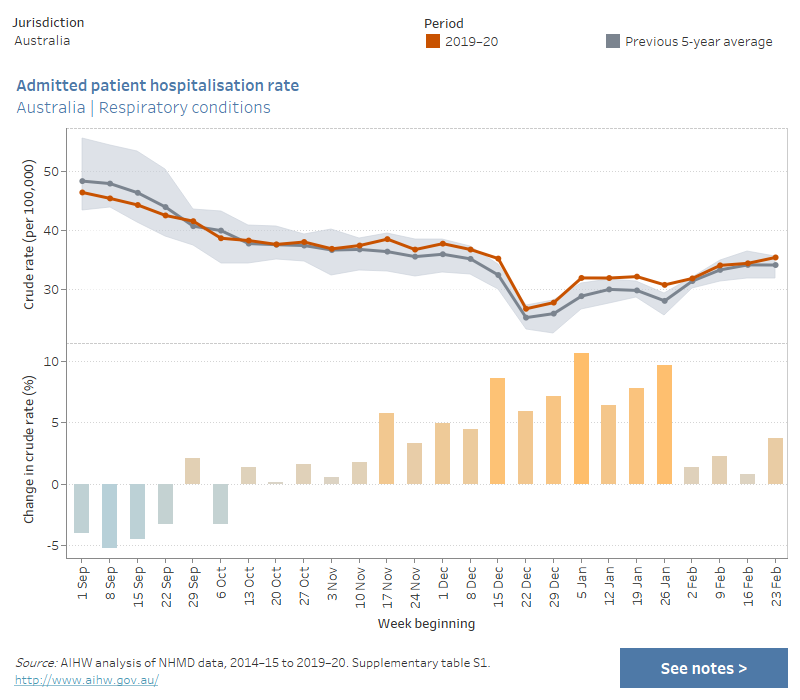Mental health-related conditions
The effects of bushfire are associated with mental health impacts (Gibbs et al. 2016; Laugharne et al. 2011). Consequently, some people’s mental health care needs may require admission to hospital. Therefore, hospitalisations with a principal diagnosis for mental health-related conditions (ICD-10-AM codes F00–F99), were analysed.
Nationally, the greatest increase in the hospitalisation rate was 17% in the week beginning 29 September 2019—38 per 100,000 persons (about 9,500 hospitalisations), compared with the previous 5-year average of 32 per 100,000 (an average of about 7,800 hospitalisations). However, it should be noted that it is difficult to ascertain the extent to which this increase was influenced by bushfires and bushfire smoke pollution or other factors.
Furthermore, there has been an increase in the mental health-related hospitalisation rate over time; for example, the national mental health-related conditions hospitalisation rate increased by an average of 3.2% per year between 2014–15 and 2018–19 (AIHW 2021; supplementary tables). Therefore, interpreting changes in rates relative to the previous 5-year average should be considered with caution.
To explore national data and data for states and territories, see interactive data visualisations below (for data tables see Supplementary table S1).
Admitted patient hospitalisation rate, by jurisdiction, mental health-related conditions (ICD-10-AM codes F00–F99), weeks in 2019–20 bushfire season relative to previous 5-year average
This combined chart shows the crude rate of admitted patient hospitalisations (per 100,000 persons) for mental health-related conditions for the periods 2019–20 and the previous 5-year average, and the percentage change in crude rate between the two periods. Data are presented by jurisdiction and by week, for the period 1 September to 29 February/1 March, which correspond to the bushfire season. The chart shows that nationally, compared to the previous 5-year average, the greatest increase in the hospitalisation rate was 17% in the week beginning 29 September 2019. There were also variations at the jurisdictional level.

At the state and territory level, examples of large increases in the hospitalisation rate for mental health-related conditions coinciding with periods of significant fire activity or air pollution include:
- a 12% increase in the week beginning 5 January 2020 for New South Wales residents—34 per 100,000 persons (about 2,800 hospitalisations), compared with an average of 31 per 100,000 persons in the previous 5-year period (an average of about 2,400 hospitalisations)
- a 21% increase in the week beginning 24 November 2019 for Queensland residents—58 per 100,000 persons (about 2,900 hospitalisations), compared with an average of 48 per 100,000 in the previous 5-year period (an average of about 2,300 hospitalisations).
At the level of Statistical Area Level 4 (SA4), examples of large increases in the hospitalisation rate for mental health-related conditions coinciding with, or following, periods of significant fire activity or air pollution include:
- a 60% increase in the week beginning 5 January 2020 for Hunter Valley (excluding Newcastle) residents—40 per 100,000 persons (about 115 hospitalisations), compared with an average of 25 per 100,000 in the previous 5-year period (an average of 68 hospitalisations)
- a 111% increase in the week beginning 17 November 2019 for Townsville residents—70 per 100,000 persons (about 165 hospitalisations), compared with an average of 33 per 100,000 in the previous 5-year period (an average of 78 hospitalisations)
- a 57% increase in the week beginning 19 January 2020 for South Australia – South East residents—42 per 100,000 persons (82 hospitalisations), compared with an average of 27 per 100,000 in the previous 5-year period (an average of 51 hospitalisations).
For data by Statistical Area Level 4 (SA4), see Supplementary table S2.
References
AIHW (Australian Institute of Health and Welfare) 2021. Mental Health Services in Australia. Web report updated 18 May 2021. Viewed 13 July 2021.
Gibbs L, Bryant R, Harms L, Forbes D, Block K, Gallagher HC et al. 2016. Beyond bushfires: community resilience and recovery: final report. Melbourne: University of Melbourne.
Laugharne J, Van de Watt G & Janca A 2011. After the fire: the mental health consequences of fire disasters. Current Opinions in Psychiatry 24(1):72–7.


